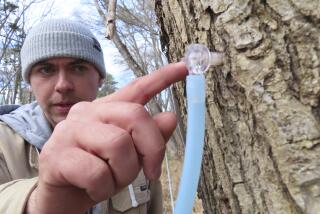Tough Tree Threatens New England’s Arboreal Symbol
- Share via
SPRINGFIELD, Mass. — Even its harshest critics can’t deny the beauty and toughness of the Norway maple.
But now some fear the immigrant tree that turns city streets to gold in autumn could snuff out the native maples that set the New England hills ablaze in crimson and orange.
“The damn things will grow anywhere,” said Charlie Burnham, manager of forest health for the state Department of Environmental Management.
So far, state foresters say, the impact has mainly been along roadways where Norway maples are slowly squeezing out less salt-resistant sugar maples. And along some flood plains, including Connecticut’s Fairfield County, thick clumps of Norway maple seedlings have crowded out native red maples.
The faster-growing Norway maple still needs to be provided a clearing or other opening before it can crack a maple forest, the scientists said. But any threat to its signature tree sends a shudder through rural New England.
“We should have learned with our experience with Dutch elm disease,” Burnham said. “You get too many of one thing, and when something adversely affects it you are in real trouble.”
The region has lost two of its popular native shade trees, chestnuts and elms, to diseases spread by introduced insects.
And Norway maples, now the most numerous city tree, have also proved vulnerable. Over the last two years thousands have been felled in New York City and Chicago by an accidentally introduced wood-boring insect called the Asian long-horned beetle, which has just as voracious an appetite for native maples.
So far, the beetle hasn’t been able to expand the beachhead it has established in the two metropolitan areas. But the states of Vermont and New Hampshire have already drawn up battle plans just in case, and foresters throughout New England are distributing wanted posters and keeping a wary watch for the insect.
Still, some urban foresters say that there is a good reason so many city streets are lined with Norway maples.
“It’s good-looking, tolerant and fairly long-lived,” said David Bloniarz, who heads the U.S. Forest Service’s Center for Urban and Community Forestry for New England and New York in Amherst.
The larger problem may be in the suburbs, where a maroon-leafed variety of Norway maple is what many new homeowners get when they ask their builder for a “red maple,” he said. Bloniarz and others are encouraging cities to diversify their plantings.
So many city trees were lost to Dutch elm disease in the 1960s that there was a scramble to replace them quickly, said Edith Makris, who heads the state Department of Environmental Management’s urban forestry program. Norway maples, which look good quickly and are cheap, seemed to fit the bill.
“So even though we knew from our experience with the elms that it was a bad idea to concentrate on one species, we did it again,” she said.
The Norway maple is not the perfect street tree because of its aggressiveness, she said. The canopy grows so thick that it is difficult to grow grass in its deep shade, and the roots have a tendency to tangle and strangle the tree after 20 to 30 years.
“That’s another problem,” she said. “Most all of them are the same age.”
Still, once a tree is growing on a city street it’s pretty much there to stay unless it sickens, said Ed Casey, Springfield’s city forester.
“Those red-leaved ones are a lot of people’s favorite tree,” he said. Still, Casey said, whenever he has a chance to replace a Norway maple or put in new trees, he tries to plant some other species.
With its tourist industry and position as the nation’s leading producer of maple syrup, Vermont takes its maples seriously. Very seriously. And not just for their economic value.
“They symbolize New England, whether it is the fall foliage in the Berkshires, Vermont, Connecticut or Maine,” said Brent Teillon, chief of forest resource protection for the Vermont Department of Forest and Parks.
Still, when he needs to plant a tree in a squeezed site on a city street that gets a heavy dose of winter salt, Teillon chooses a Norway maple.
More to Read
Sign up for Essential California
The most important California stories and recommendations in your inbox every morning.
You may occasionally receive promotional content from the Los Angeles Times.













